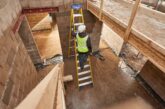
Gurjeev Bola, UK Product Manager for Werner, shares the key considerations when choosing the correct product for the job and best practices on how to stay safe when working at height.
It may seem obvious that safety is of paramount importance when working at height. However, there are still a shocking number of accidents happening in the work place as a result of a fall from height. While working on ladders might feel like second nature, it can be easy to overlook simple yet vital safety practices when carrying out everyday jobs.
According to latest reports from the Health and Safety Executive (HSE), falls from height accounted for 44 per cent of all non-fatal injuries over the past 5 years and 25 per cent of all fatal injuries. It is, therefore, crucial that professionals follow best practice guidelines to make working at height both easier and safer.
Assessing the risks
The Work at Height Regulations 2005 (WAHR) state that employers and those in control of any work at height activity must make sure work is properly planned, supervised and carried out by competent people. This includes using the right type of equipment for working at height.
Carrying out a risk assessment is a vital part of the planning for any job, no matter how small. As well as looking at the site itself, the type of equipment chosen plays a major part when it comes to minimising risk and working safely. Factors to weigh up include the height of the task; the duration and frequency of the task; and the condition of the surface being worked on.
Although it may be the easiest option, a ladder is not always the safest solution for working at height. If, for example, where it is not possible to maintain three points of contact on a ladder, or if the job at hand is likely to take longer than 30 minutes. In these instances, the use of alternative access equipment, such as an access platform or scaffolding, would be recommended to remain safe.
Choosing the right equipment for the job
Choosing the correct sized product for the job is imperative for working at height safely. All access equipment has a specific height that it can reach, so it’s vital that this is taken into consideration prior to starting a project.
When considering the choice of ladder type it’s important to ensure it’s right for the application – for example, if there is a need to have a platform to work from, or a large amount of tools are needed for a job, then a ladder may not be appropriate. Due to the flexible height adjustment and sturdiness they offer, adjustable work platforms can be used to carry out the job safely if a ladder isn’t suitable.
Ladders also come in a variety of materials with aluminium and fibreglass being the two most common. Aluminium ladders have the benefit of being lightweight and strong, as well as rust and corrosive proof, whereby fibreglass ladders offer a non-conductive work at height solution, ideal for minimising the risk of shocks for those working in electrical environments.
Assess before every use
As ladders are in constant use, it can be easy to overlook potential wear and tear, therefore regular inspections should be carried out before each use to ensure its ongoing safety for users.
These inspections should be carried out by a competent person who can identify problems at an early stage. These reviews should include pre-use checks, detailed inspections and interim inspections as appropriate. All of these checks should identify defects or damage that may affect safety.
Invest and train
When purchasing any equipment for a job that involves risk, it is always advised to invest in high-quality products that are sourced from reputable and trusted manufacturers. Cheaper tools may not have been tested to the same standards as a certified and trusted manufacturer, therefore, may not guarantee the same level of safety.
However, having the most suitable access equipment is only part of the solution if the user isn’t trained to use it. Ensuring relevant training is undertaken by all users is key to maximising user safety and minimising the risk of accidents.
With so many access equipment options available, Werner has developed a handy guide which is available online to help professionals choose the right ladder for the job and provide reliable solutions with products that are manufactured to the highest industry standards. Additionally, a range of training courses are available at WernerCo to ensure users are confident undertaking the job which includes Ladder and Stepladder courses for both inspection and users.
By taking the time to ensure the correct access equipment is chosen when working at height, hopefully productivity can be increased and more accidents can be prevented.
To find out more about the access solutions available from Werner visit https://www.wernerco.com/







